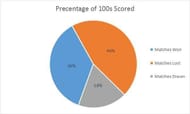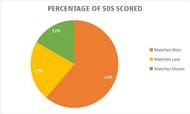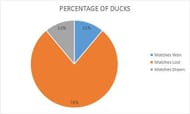
“Please note that all calculated metrics below are up until 11th May 2018 which is before Pakistan’s first test against Ireland. This piece effectively tries to answer a lingering question that has most notably never been addressed in the course of Pakistan cricket, for the last few years.
The analysis presented in the following literature and in the Appendix ‘A’ is based on statistics provided via the open source Stats guru module on espncricinfo which has then been tabulated independently via a 3rd party spreadsheet program, (Refer Appendix A, 5.)”
Ever since time immemorial, Pakistan cricket has been associated with a mercurial flair that is particularly unique to them. On most occasions, the green mavericks are termed, and rightfully so, bitterly inconsistent, yet at the same time, many fans and critics alike see them as quite a robustly entertaining bunch as well.
The 2010 spot-fixing saga and the preceding months leading to such saw this same latter pendulum swing to an extent that, even by Pakistani standards the disintegration had most probably reached a point of no return.
However, six years down the road that very team, which lost its respect at one of the most iconic cricketing venues, saw them return as conquering heroes and a deserving position at the top of the test summit.
Shafiq's role leading up to the first Irish Test
Asad Shafiq, who was one of Captain Misbah’s trusted generals in this entire journey, played a pivotal key role in making sure that Pakistan’s test batting had a reliable rear guard and in whatever capacity he was engaged upon, Shafiq went on to challenge the very best by setting new records at the number (6) batting position.
Characteristically, Shafiq is not the most assertive batsman going around in world cricket. He intrinsically lacks the ‘Pakistani flair’ which the Pakistani fans generally tend to associate with their local heroes but on the flip side, Asad manages to draw up performances that on a spectrum are entirely un-Pakistani, in every sense of the word.
This piece, however, isn’t a critical examination of his failings neither is it a celebratory psalm on his Soberesque number of centuries at the number (6) position but, is a study on the impact he sheds upon the game and the XI that dons the golden star and crescent.
Ideally, to find such an impact it is of paramount importance that we may look at Shafiq’s metrics via some standardized benchmarks and for this very reason I have taken Shafiq’s contributions in ‘Matches Won’, ‘Matches Lost’ and ‘Matches Drawn’ at a per inning basis.
Compartmentalized Batting Metrics based on Match Results

Let’s get some obvious facets out of the way, right off the bat. According to the tabulated results Shafiq is best suited to play as the designated rearguard given that his run per innings (a batting metric much more detrimental than the average) is 40.xx along with a 55+ average in all matches Pakistan have successfully drawn since 2010.
Ironically Shafiq’s debut also happened under similar circumstances when he had to irk out a very useful 61 run inning against a South African pace attack consisting of Steyn, Morkel, and Kallis helping Pakistan draw the second test in Abu Dhabi back in 2010.
His most number of not outs (4 out of the 6 he’s had in his career) have also come in a rearguard effort which aptly signifies his forte of providing stability in the lower middle order, however, what works against this ideal is his significantly lower sample size for the said numbers.
What do the metrics tell us?
Throughout his career, Asad has only 15 innings in which he’s managed to claim a draw for Pakistan. The number amounts to almost 15% of the overall number of innings throughout his career and rightly so his tally of 605 runs in those fifteen innings conjures to approximately 16% of his overall career runs as well.
If we then move onto the balls faced, then approximately 18% of all balls faced by Shafiq are distinctly in matches that have been drawn.
Compare the preceding tally with his numbers, for matches in which Pakistan has lost, and it becomes entirely evident that Shafiq’s runs impact very little for the overall outcome of a game.
In 46 such innings Asad has amassed nearly 1400 runs which put his average and RPI both at 30.13, 9.xx and 7.xx runs less than his career figures respectively, while if we take a mean for the balls faced per innings in matches lost then it further glaringly indicates Shafiq’s inability to prolong his stay at the crease when the going gets tough.
In matches won or drawn, Asad’s average balls faced per innings hovers between 90-93 balls (Approximately 15 overs) for all games irrespective of the whichever innings or whatever venue he might be batting in.
However, in matches lost Shafiq’s mean balls faced per innings drops to 60.xx (Approximately 10 overs), nearly 30 less than in matches won or drawn and 18 less than his overall career metrics.
Asad’s impact can further be gauged by the sheer fact that a greater part of his century making, at the business end of any game, most often than not turns out to be what many cricketing fans label as ‘soft runs’ since they do not necessarily impart any weightage to the overall outcome of a Test match.
By pie charting the results of all his hundreds, half-centuries and his ducks we can most assuredly get an idea of why a lot of informed fans might be totally skeptical of whether Shafiq can be a reliable middle order batsman post the Misbah-Younis era.
Percentage Analysis on scores based upon batting landmarks



Five centuries out of the eleven he’s scored throughout his career have been in a losing cause and apart from the one innings, in Cape Town in 2013 where he scored 111, all of the remaining such hundreds have come in either the 3rd or the 4th Innings of a game.
The tally for such comes to 46% of all centuries Asad might score irrespective of opposition or venue while if we chart his total number of runs in these matches lost, then 38.xx % of them have been in games that have been unsuccessful for the Pakistan Team.
Funnily enough, Shafiq scoring a 50 rather than a hundred dramatically reduces the chance of a Pakistan loss. Only 22% of all his half centuries (4 out of an overall 18 he’s scored in career) are in losses which mathematically tells us that the best case scenario for Shafiq making runs is when he might score anything in the range of 40 ≤ x < 100.
This is also due to the fact that his RPI in ‘Matches Lost’ caters to 30.xx and he has 78% of all his ducks (including a few pairs) in these mentioned games. To put it in layman terms, any score between 0 to 30.xx serves no purpose whatsoever to the overall final result of the Test Match.
Playing second fiddle
Another key indicator of his runs having a lack of impact is if we delve into the inning by innings comparison of all the ‘Matches Won’ by Pakistan ever since his debut (Refer Appendix A, 1).
In such games, Asad has only ever carried the baton on just two separate occasions, once at Hamilton against New Zealand in 2011 where he top scored with an 83-run inning for Pakistan and directly contributed to the win and the other occasion being in Galle, in 2015 where again he top scored with 131 and helped defeat Sri Lanka.
On all other occasions, in ‘Matches Won’ or even in ‘Matches Drawn’ Shafiq has always played second fiddle to a primary top-order batsman who might have taken charge of proceedings.
These types of instances show that Asad severely lacks the necessary impact to force a result on the game and needs a partner in crime to help achieve anything substantial whatsoever.
It is also critically important to know that Shafiq even when is scoring centuries in ‘Matches Won’ always is overshadowed by a better performing batsman be it Younis Khan, Misbah ul Haq, Azhar Ali, Sarfraz Ahmed or even on some occasions Shan Masood and Mohammad Hafeez.
An argument in favor of Asad Shafiq
Although the above statistics clearly indicate that Shafiq hasn’t had a substantial impact on wins and has failed to make a mark during the business end of a run chase, what works in his favor is the simple fact that Asad has always been assigned to play with the lower middle order or the tail.
Most often than not he ends up either running out of reliable partners or needs to up the ante to secure a win or a draw resulting in him losing his wicket as shown in the Appendix A, 2,3 and 4.
The upcoming Ireland test will be the perfect opportunity for Shafiq to shed this particular aspect of his game and step up to the plate in the absence of Misbah and Younis.
If we are to believe the team strategy going into the English summer, which ascertains of him hogging the number 4 batting position, then Asad clearly needs to take responsibility and show that he’s ready to claim as one of the mainstay batting pillars of the Text XI. Only time will tell whether he’s up for the challenge or will continue a similar patchy record that he’s accomplished so far.
Appendix A

2.

3.

4.

5. Raw Spreadsheet (click to view)
Looking for fast live cricket scores? Download CricRocket and get fast score updates, top-notch commentary in-depth match stats & much more! 🚀☄️
